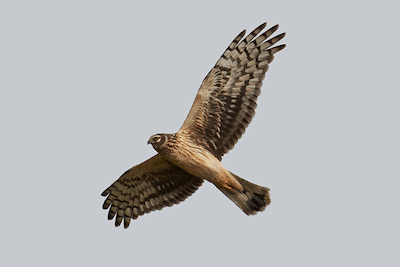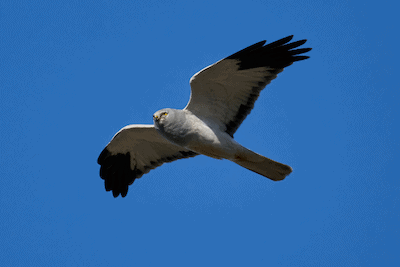Hen Harrier
(Circus cyaneus)
As a typical harrier, the Hen Harrier hunts by flying low over open land with low vegetation, and pounces on prey that it surprises out in the open.

The Hen Harrier used to be common in Europe before agricultural practices became increasingly intensive, but is now mostly found in remote areas, such as tundra, moorland, and grassland.
In order to ensure the survival of Hen Harriers in Europe, it’s essential to focus efforts on preserving and recreating suitable habitats for it.
Since many plant and animal species that are found in open countryside face a similar plight to the Hen Harrier, restoring suitable habitats for it will simultaneously help many other species.
Hen Harrier facts
Previously one of the most common resident harriers in Europe, the Hen Harrier is now more often observed on migration in large parts of Europe.
Hen Harrier size
The Hen Harrier is a medium-sized raptor that resembles other European harrier species in size.
- Wingspan: 100-120 cm
- Length: 42-52 cm
- Weight: 375-600 g (female), 300-400 g (male)
While female Hen Harriers reach a wingspan that is similar to a Common Buzzard, males are smaller than this.
Compared to other European harriers, this bird is very similar in size to the Montagu’s Harrier (Circus pygargus) and Pallid Harrier (Circus macrourus), while it is slightly smaller than the Western Marsh Harrier (Circus aeruginosus).
Appearance
The Hen Harrier looks like a medium sized raptor, and resembles a Hawk in its overall appearance and silhouette (especially the female).
However, in contrast to the hawk species in Europe, the Hen Harrier has longer wings and a shorter tail, and can also be easily distinguished based on its behavior and choice of habitat.

Sexual dimorphism
Similar to other bird of prey species in Europe, female Hen Harriers are significantly larger than males. While female Hen Harriers reach a wingspan that is similar to the Common Buzzard, males are clearly smaller.
In addition to size differences, the two genders of the Hen Harrier also have different colored plumage. While the female is predominantly light brown with dark brown speckles and bars, the male is almost entirely light grey, with dark wingtips.
Lifespan
A maximum age of 16 years has been recorded in the wild.
Scientific name and taxonomy
The scientific name of the Hen Harrier is Circus cyaneus. This bird is monotypic, meaning there are no known subspecies. It was previously thought to be the same species as the Northern Harrier in North America, but DNA analysis has shown that they are actually separate species.
Hen Harrier distribution
The Hen Harrier has a broad distribution range, but is absent from many parts of that range, making its distribution rather patchy. It is found in the British Isles, France, Spain, Ireland, Scandinavia, Belarus, and the European part of Russia. Its range extends eastwards from there all the way to the Pacific.
There are small populations of Hen Harriers in Poland, Germany, and Ukraine, but this bird is absent from many European countries, including all of south eastern Europe.
Hen Harrier habitat
The Hen Harrier prefers open countryside with low vegetation, but not marshes or wetlands. It is most commonly found in the tundra, moorland, plains, or grassland that is not intensely cultivated.
Hen Harrier population size
The European population of the Hen Harrier is estimated to be between 32,000 and 59,000 breeding pairs by BirdLife International. The largest population is in the European part of Russia, with up to 40,000 pairs, followed by Finland (up to 3,500 pairs) and Spain (up to 1,100 pairs). Outside of these countries, most populations are much smaller and have a disjointed range.
Hen Harrier behavior
Similar to other harrier species, the Hen Harrier hunts by flying slowly at low height over open countryside, and stooping down on prey that it encounters out in the open.
Feeding and diet
The main food source of Hen Harriers are small rodents, with the exact species depending on the location. In many cases voles are the prey species. In addition to rodents, it also regularly takes young rabbits and young birds, as well as reptiles and insects.
Breeding
Similar to other harriers, Hen Harriers nest on the ground, and require an area with dense vegetation in order to protect the nest, such as reed beds in marshy areas. The female lays 4-6 eggs, which are incubated for up to 31 days. After hatching, the young harriers stay in the nest for up to 39 days, and continue to be fed after leaving the nest.
Migration
The Hen Harrier is a partial migrant, with northern and eastern European populations migrating to western and southern Europe, while other populations are largely sedentary.
Western and central European populations stay in their breeding areas unless the weather conditions get really bad, and can sometimes be observed migrating in the middle of winter, as they try to evade unfavourable conditions.
Hen Harrier conservation status
The overall population of the European Hen Harrier appears to be more or less stable, and its common enough to be classified as of “Least Concern” by BirdLife International.
However, in many parts of its range, this bird has a patchy distribution, and local populations often consist of just a handful of pairs, which makes it vulnerable in these areas.
Because of this, it’s essential to monitor the Hen Harrier population closely in Europe, in order to ensure this beautiful raptor of Europe will survive.
Threats
The biggest threat to Hen Harriers is the destruction of their habitat due to intensification of agricultural practices. Following this, illegal killing is a big threat, which unfortunately occurs in areas where game managers want to increase local grouse populations by getting rid of these raptors.
Additional resources:
- European Sparrowhawk migration
- Northern Goshawk distribution and habitat
- Levant Sparrowhawk migration patterns
